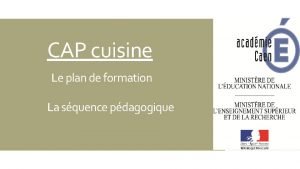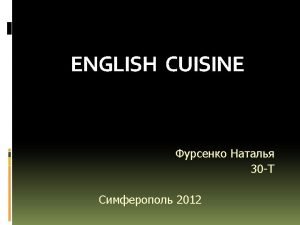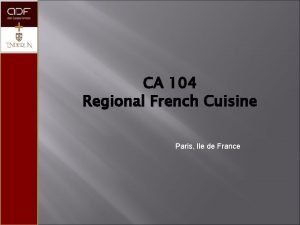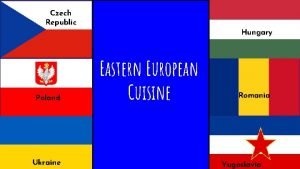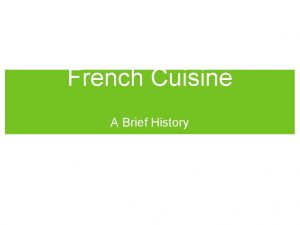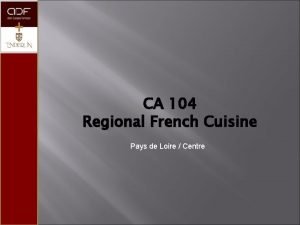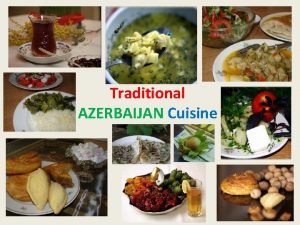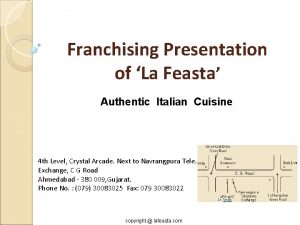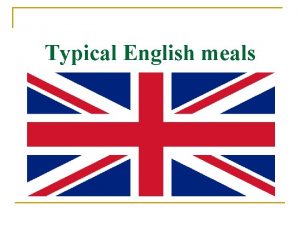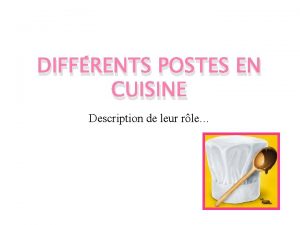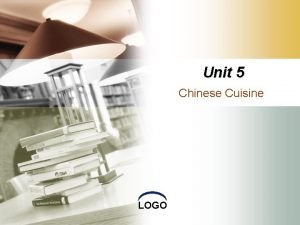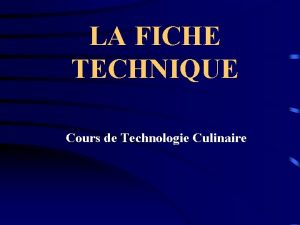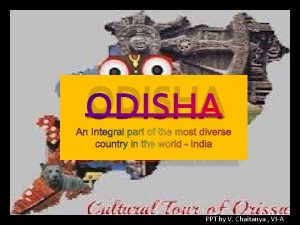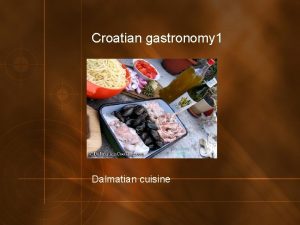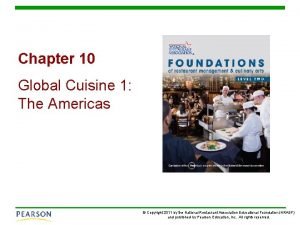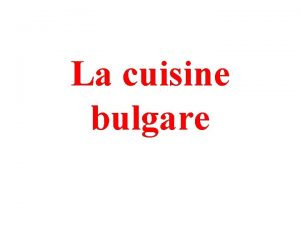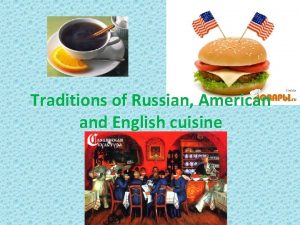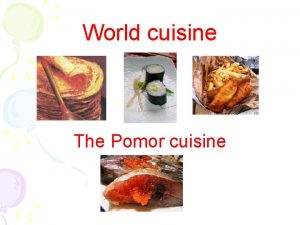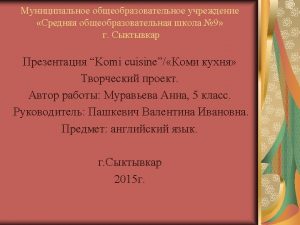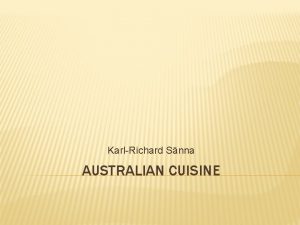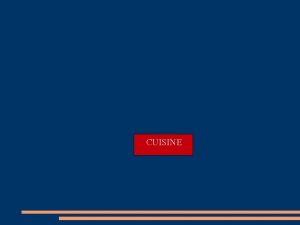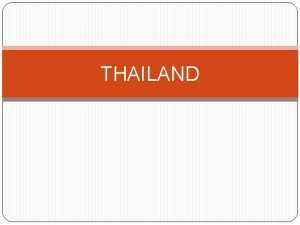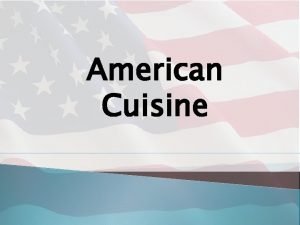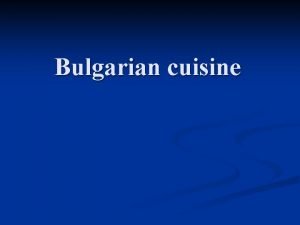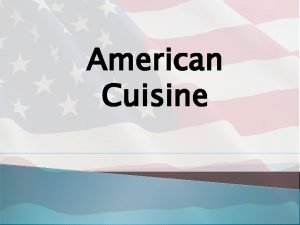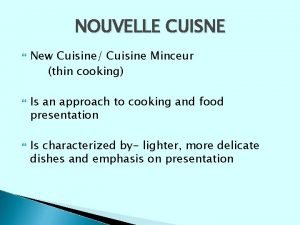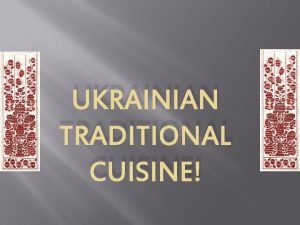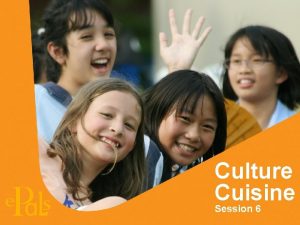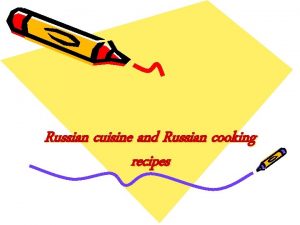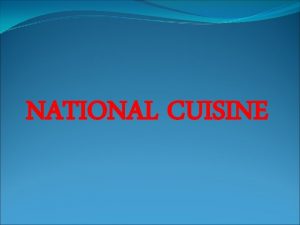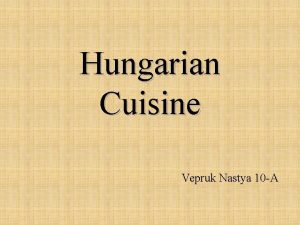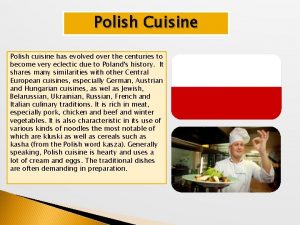The Cuisine of Thailand Satellite View of Thailand



































- Slides: 35

The Cuisine of Thailand Satellite View of Thailand Surroundings Source: http: //www. axolotlvillage. comimagesthailand-maps. jpg

Overview l l l The first independent Thai kingdom (Sukhothai – 13 th Century) was the beginning of the evolution to modern Thai cuisine. During the centuries after the Sukhothai, many ingredients have appeared through different cultures. These new ingredients have been refined to create a distinctive Thai cuisine. This cuisine is a complex art that is exemplified in two categories: Home Thai cooking with regional variations and Royal Thai cuisine. An important element of the traditional Thai kitchen are utensils. There a few utensils that no kitchen should be without in order to properly prepare some commonly used Thai ingredients. In home Thai cooking, there are four regions where food variations can be identified: north, northeast, central plains, and the south. Each region varies from one another in at least a few of the following categories: cultural food influences, climate, terrain, ingredients, food preparation, dishes, and food service practices.

Overview Continued l l Thailand’s climate is considered to be Tropical. Concerning weather, the country can be split into two sections. The north, northeast, and the central plains can be identified by three seasons while in the south only two seasons are identifiable. Royal Thai cuisine has a rich history that began in the Grand Palace located in Bangkok. Royal Thai cuisine has one main difference from regional Thai home cooking. The difference is a heightened sophistication. The difference in sophistication can be measured in two areas, flavor and presentation. Thai cuisine has evolved into a complex cuisine with many variations in flavors, ingredients, techniques, and sophistication.

History of Food in Thailand l l The King of the first independent Thai kingdom (Sukhothai) was King Ramkhamhaeng. A stone tablet from his kingdom was found bearing the inscription “In the water there are fish, in the fields there is rice. ” This marks the acknowledgement of two foods that remain important to the Thai diet. Source: http: //www. jaars. org/museum/alphabet/people/graphics/ram khaeng. jpg Source: http: //www. simplythai. com/Thailand_History_Kin g_Ramkamhaeng_the_Great. ht m

History of Food in Thailand Continued l l l Fish was abundant in the waterways and the sea. On the other hand, rice was actually commonly consumed by the earliest settlers of the land. This was long before the Thai people were present. However, the Thai people can be credited for the creation of intricate paddy fields which streamlined cultivation and increased availability. Source: http: //www. thailandsouthern. com/images/rice%20 s teamed%20 with%20 fish. jpg Source: http: //www. nhm. ac. uk/researchcuration/projects/biodiversity-conservation-thailand/images/ricepaddy-habitat. jpg

History of Food in Thailand Continued Popular Thai Cooking Fish Source: http: //www. chiangmai-chiangrai. com/images/popular_fish. jpg

History of Food in Thailand Continued l l Other than fish and rice, a wide range of different ingredients have become available over the centuries. Many cultures are responsible for the influx of new ingredients. Some of these cultures include: China, India, Persia, and Portugal. Even South America contributed the chilies that are commonly associated with Thai cuisine. Regardless of the origin of ingredients, they have been modified and refined into a distinctive Thai cuisine. Source: http: //www. davidsanger. com/images/thailand/0 -364 -13. chilies. y. jpg

Utensils of the Thai Kitchen l l The utensils commonly found in the Thai kitchen were introduced by their ancestors who migrated from China. As with any food preparation, the proper utensils are necessary to complete the task. The following utensils are considered necessities, rather than luxuries, to properly prepare common Thai ingredients: l Thai strainer – Used to strain liquids and grease from many foods. l Coconut grater – An invaluable tool for the extensive use of coconut in Thai cuisine. l Wooden chopping block – Mainly used for cutting fish and meats. l Cleaver – This is the main cutting tool of the Thai kitchen. l Glutinous rice basket (kratip) – Used to keep sticky rice warm and moist. l Mortar and pestle – Used to make curry paste and to bruise other flavorings found in Thai cuisine. l Thai stove – A simple clay structure, heated by charcoal, with an insert on the top to hold a wok or a pot. l Bamboo skewers – Used to skewer meats. l Wok – A versatile tool, uses range from stir-frying to deep-fat-frying. l Spatula – Usually made from wood or metal. It is the main tool used in wok cooking. l Coconut shell spoon – The most commonly used ladle. l Curry pot – With large handles to make carrying easy. l Steamer – Thai people eat rice with every meal. This tool makes that possible.

Utensils of the Thai Kitchen Continued Strainer Coconut Grater Chopping Block Cleaver Source for all pictures: http: //www. thaifoodtonight. com/thaifoodtonight/utensils. htm

Utensils of the Thai Kitchen Continued Glutinous Rice Basket (kratip) Mortar & Pestle Thai Stove Skewers Source for all pictures: http: //www. thaifoodtonight. com/thaifoodtonight/utensils. htm

Utensils of the Thai Kitchen Continued Wok Spatula Steamer Coconut Shell Spoon Curry Pot Source for all pictures: http: //www. thaifoodtonight. com/thaifoodtonight/utensils. htm

Home Thai Cooking - Climate l l As one might expect, climate has a huge impact on food sources. Thailand, as a whole, is considered to be a Tropical climate. However the weather of the country can be divided: l The north, northeast, and central plains have three seasons: l l November to February – The cool season. March to June – The hot season. June to November – The rainy season. The south has two seasons: l l April to October – The rainy season. November to March – The dry season. Source: http: //www. geckosadventures. com/uploads/images/climate_chart/Thailan d_climate. gif

Home Thai Cooking - A Regional Cuisine l l l Thai cuisine is a counterbalancing of sweet, spicy, sour, salty, and bitter flavors experienced throughout a meal. However, this flavor balance is achieved in many different way according to region. Each culinary region of Thailand varies from one another in at least a few different characteristics. Those characteristics include cultural food influences, terrain, ingredients, food preparations, dishes, and food service practices.

Home Thai Cooking – The Northern Region – Terrain and Cultural Influence l The two main food influences of the north comes from China and Myanmar (previously Burma). l l The Chinese influence is mainly reflected in the widespread use of noodles. The Myanmar influence is found in northern style curries and chili paste dips (nam phrik) Source: http: //www. sumitkpan. ca/1%20 Chiang. Mai%20 a. JPG l. The terrain in the northern region of Thailand consists of mostly jungle-covered mountains and valleys. Source: http: //eatingasia. typepad. com/photos /uncategorized/suanplu_kj_nam_ya. j pg Source: http: //farm 2. static. flickr. com/1254/782844746_7 c 59794 e 19_o. jpg

Home Thai Cooking – The Northern Region – Ingredients l l The cold mountain areas produce some things people might not expect such as strawberries, apples, and carrots. A common food item in northern Thailand is called naem. Naem is a pork sausage that is distinctive to the north. This sausage is used in many different ways including being eaten raw, with rice, or mixed into various dishes. Source: http: //www. hotelthailand. com/tha iland/images/strawberry. gif Source: http: //paulmirocha. com/resourc es/images/sketchbook/water_ap ples. jpg Source: http: //coursewares. mju. ac. th/ft 470/photo/Naem. jpg Source: http: //asiarecipe. com/images/v eg_carrot. gif

Home Thai Cooking – The Northern Region – Food Service l l Food service is unique in the north. Most meals are eaten while sitting on straw mats while gathering food from a kantoke. A kantoke is a small, round table usually made from oak which looks like a tray with legs. On the kantoke, a selection of entrees are offered including curries, sticky rice, various par-boiled vegetables, deep-fried fish, and choices of chili paste dips. Source: http: //www. thaiwaysmagazine. com/thailand/image/khantok. JPG

Home Thai Cooking – The Northeastern Region – Terrain and Cultural Influence l l l Source: http: //www. siamwanderer. com/Regions/Isan/d&sme 1. jpg The most influential culture on the northeast comes from the neighboring country of Laos. This is evidenced with glutinous rice being a staple food which is consumed both as a base for meals and as dessert. The kratip is a cultural icon of the northeast. Other evidence is in the wide use of herbs, especially common Laotian herbs such as dill. It is not common to use dried herbs in the northeast. However, condiments, such as fish sauce, are often used. l. The northeast region of Thailand, which is also known as Isan, is a high plateau with low rainfall and porous soil. Source: http: //farm 2. static. flickr. com/1276/10042 http: //www. gourmetsleuth. com/im http: //www. brucelawson. co. uk/plogger/t 00487_f 528 be 6 c 06. jpg ages/tiparos. jpg humbs/lrg-887 -img_6243__large_. JPG

Home Thai Cooking – The Northeastern Region – Ingredients Source: http: //alum. mit. edu/ne/whatmatters/20010 7/images/owen 1 -8. jpg Source: http: //dan. doxdesk. com/file/Travel%20 phot os/04. %20 Thailand/Bangkok/Snakes. jpg Source: http: //rastrup. files. wordpress. com/2007/07/fried-bugs. jpg l l Some of the most commonly used ingredients is the northeast include chilies, tamarind, fish, and sausage. Freshwater fish and shrimp are the main sources of protein in the northeast. However, the people of the northeast have a reputation for eating anything for protein including frogs, birds, snakes, and inscets.

Home Thai Cooking – The Northeastern Region – Dishes and Food Service l A number of popular dishes originate in the northeast. Two of theses dishes are: l l Som Tam – A spicy raw papaya salad mixed with chilies, garlic, tomatoes, green beans, lime juice, and fish sauce. Larb – A sour minced beef, pork, or chicken salad. Also, curries made without coconut milk are popular in this region. In the northeast, meals are generally eaten on a pa kao table made from either bamboo or rattan. Source: http: //www. backpackthailand. com/i mages/thai_food. jpg Source: http: //www. wired 2 theworld. com/ Thai 06248 somtam 2. jpg Source: http: //www. pbase. com/soleilmia/image/4846 0392. jpg

Home Thai Cooking – The Central Plains Region – Agriculture and Dishes l l The central plains region has long been considered the economic and cultural center of Thailand. The floating food markets that some people may associate with Thailand are common to this region. The Chao Phraya River flows through this region which makes the land fertile and supplies many freshwater fish. Rice is the main agricultural product; however, a variety of fruits, vegetables, and flowers are grown. Some commonly grown fruits include: l l Mango Durian Custard apple Pomelos guava l Source: http: //www. shunya. net/Pictures/Thailand/Floating Market 2. jpg Source: http: //www. spurgeon. org/~phil/images/durian. gif Source: http: //www. chefsinsa. co. za/Trai ning/trainingpics/custard%20 ap ple. jpg Source: http: //img. alibaba. com/photo/513 56105/Honey_Pomelo. summ. jpg

Home Thai Cooking – The Central Plains Region – Agriculture and Dishes l l Unlike the north and northeast regions, plain jasmine rice is preferred. Rice is usually prepared steamed, but sometimes boiled or fried. The vast availability of fresh seasonal ingredients contributes to dishes found in the central plains. l Source: http: //www. duelliscool. net/veggies 1. jpg l l For example, nam phrik, the chili paste dip that is popular in other regions, is served with fresh seasonal vegetables such as cucumber, morning glory stalks, makok leaves, cha-om, and gratin. Another example would be spicy Thai salads with the addition of lemongrass, kaffir lime leaves, and herbs. In the central plains region, dishes are simplistic and rely mostly on the ingredients for acclaim.

Home Thai Cooking – The Central Plains Region – Dessert l l l Desserts are popular in the central plains region. Although many techniques are employed, most desserts share three main ingredients: flour, coconut, and sugar. Also, fruit is commonly used in the making of desserts. l For example, a popular dessert consist of the addition of fruit to a light clear syrup and crushed ice. Source: http: //www. tcie. com/coconutcraft/images/coconut 1. bmp Source: http: //farm 1. static. flickr. com/151/430148682_f 889 cac 654. jpg

Home Thai Cooking – The Southern Region – Terrain l The southern part of Thailand is a long peninsula covered with flourishing jungle. Located on opposite sides of the peninsula are the Indian Ocean and the Gulf of Thailand. The coast mainly consists of beaches and fishing ports. Along the center of this region rugged limestone mountains can be found. The south is also the home to some enormous plantations producing pineapple, coconut, and rubber. Source: http: //alpineclub. stanford. edu/images/tonsai. jpg

Home Thai Cooking – The Southern Region – Cultural Influences l l l Source: http: //www. guidelive. com/feature/297/thai. jpg Southern Thailand shares a border with Malaysia. Due to the large Muslim population of Malaysia, an Islamic cultural aspect is present in the food of southern Thailand. In specific, there is a wide use of turmeric, which gives southern food a yellowish color. Some examples are: l Gaeng lueng – Spicy coconut shoot soup. l Khao mok gai – Turmeric rice topped with chicken. l Gaeng som – tamarind flavored soup. Southern curries also tend to have an Indian influence. One such curry is called massaman. Massaman uses curry ingredients common to other regions of Thailand; however, cardamom, cloves, and cinnamon are incorporated which is common in India. This type of curry, as well as many dishes from the south, is presented with peanuts.

Home Thai Cooking – The Southern Region – Cultural Influences Source: http: //www. thailandlife. com/food/satay. jpg l Indonesia has influence on southern dishes. l l Source: http: //www. thaiblogs. com/media/chinesefestival 2. jpg Satay, a traditional Indonesian dish, is common in the southern region. In southern Thailand, satay is usually eaten with a spicy peanut sauce. The south is the home to a large Chinese community which lends further cultural influence. In fact, the Chinese community holds a vegetarian festival in Phuket every year.

Home Thai Cooking – The Southern Region – Ingredients l l Common ingredients in southern cooking are characterized by local produce. Many dishes use coconut as the main ingredient; coconut milk is used to cool the chilies in curries and soups, coconut flesh is grated and served as a condiment, coconut oil is used for frying. Given the overwhelming presence of water, southerners enjoy an abundant supply of seafood. Many southern dishes include seafood such as rock lobster, fish, crabs, prawns, squids, clams, and mussels. Some of the most famous seafood dishes are: l l l Goong ga-thi nor mai sod – Prawns and bamboo shoots in coconut soup. Poo pad pong gari – Fried crab with yellow curry. Goong pad sataw – Fried prawns with twisted cluster beans. Source: http: //www. dkimages. com/discover/previews/796/50086719. JPG

Royal Thai Cuisine l l l Royal Thai cuisine refers to the food preparation that originated in the Grand Palace located in Bangkok. This mile-square area is where the women of the Royal Court lived. This area was a complete town in itself. It had a tight network of housing with narrow streets, gardens, lawns, artificial lakes, and shops. Also, it had its own government, institutions, laws, and courts. At the height of the Grand Palace, during the reign of King Rama V, the population consisted of nearly three thousand women. Of those three thousand women, a few were ranked as Queens, but the majorities were ladies-in-waiting and lower attendants. The inner palace was where these women were taught the most refine aristocratic skills. These skills were expected to be perfected and passed on.

Royal Thai Cuisine Continued l The royal women of the Grand Palace were taught how to prepare various foods. The foods they were taught to prepare varied from outside regional cuisine. There is one main difference between Royal Thai cuisine and regional home Thai cooking, and that difference is sophistication. l l l Sophistication can then be broken down further into two categories which are flavor and presentation. Palace food was meant to be subtle in flavor and highly memorable in visual appeal. The most visible palace skill was the art of fruit and vegetable carving. These carvings were mainly used as garnishes. Some of the carvings were so intricate that they took as long to create as the dishes they were garnishing.

Royal Thai Cuisine Continued l The characteristics of palace cooking included meticulous hours of preparation and a highly refined presentation style. Two examples are: l l l Foi thong – A blend of egg yolks and sugar transformed into a nest of golden threads. Look choop – Tiny imitation fruits shaped by hand from a mixture of sweet bean paste and coconut milk to exactly match their real-life counterparts. Under the rule of King Rama VI royal polygamy came to an end. After this change, the ladies of the Grand Palace slowly left the community. However, palace cooking continued to survive through the descendants of these royal women. Today, a number of restaurants strive to recreate the intricacies of palace cuisine.

Royal Thai Cuisine Continued Source: http: //www. thai-blogs. com/media/thaidessert_2. jpg Source: http: //www. carvinginstitute. com/images/carving _gallery_alr. jpg Source: http: //www. thaiwaysmagazine. com/th ailand/image/thai_desserts. JPG Source: http: //www. crowntex. co. th/images/the_grand_palac e. jpg

Final Thoughts l Thai cuisine is rich in history. The history has served as a base for modern Thai cuisine. Modern Thai cuisine is a complex art. This is exemplified through the differences in the culinary arts of Thailand. Home Thai cooking is a flavorful cuisine, with simplistic preparation and presentation, differing by region. In contrast, Royal Thai cuisine demonstrates the lavish and sophisticated extremes of Thai cuisine. Thai cooking has certainly evolved into a complex cuisine with many variations in flavors, ingredients, techniques, and sophistication.

Some Thai Recipes Featured Nam Phrik Source: http: //www. recipesource. com/text/ethnic/asia/thai/recipe 216. txt

Some Thai Recipes Featured Continued Som Tam Source: http: //www. recipespin. com/print. aspx? id=2914

Some Thai Recipes Featured Continued Thai Curry (Massaman) Source: http: //thaifood. about. com/od/thaicurrypasterecipes/r/massamanpaste. htm

Sources Used In My Research Paper and Reflected in the Text of This Presentation * All pictures and recipes are cited within the individual slide.
 Where is africa
Where is africa View cube satellite
View cube satellite Satellite view of antarctica
Satellite view of antarctica Satellite view of antarctica
Satellite view of antarctica Cap cuisine
Cap cuisine Slidetodoc.com
Slidetodoc.com Czech cuisine of perversions
Czech cuisine of perversions Pppst clipart
Pppst clipart English cuisine encompasses
English cuisine encompasses Coulommiers pronunciation
Coulommiers pronunciation Is poland considered eastern europe
Is poland considered eastern europe Let t(x y) means that student x likes cuisine y
Let t(x y) means that student x likes cuisine y Referentiel cap cuisine
Referentiel cap cuisine Brief history of french cuisine
Brief history of french cuisine Pays de la loire food
Pays de la loire food Traditional azerbaijani cuisine
Traditional azerbaijani cuisine Lafeasta
Lafeasta Brigade de cuisine
Brigade de cuisine Typical english meals
Typical english meals Eating habits synonym
Eating habits synonym Combiné fileté
Combiné fileté Chinese cuisine logo
Chinese cuisine logo Carnet personnel de techniques professionnelles
Carnet personnel de techniques professionnelles English cuisine
English cuisine Code couleur fiche technique cuisine
Code couleur fiche technique cuisine China cuisine
China cuisine Ppt on odisha food
Ppt on odisha food Who is this person
Who is this person Dalmatian cuisine
Dalmatian cuisine Mondex smartcard
Mondex smartcard Chapter 10 global cuisine 1 the americas
Chapter 10 global cuisine 1 the americas Nourriture bulgare
Nourriture bulgare American cuisine
American cuisine Cuisine
Cuisine Komi cuisine
Komi cuisine Marche en avant dans le temps
Marche en avant dans le temps




